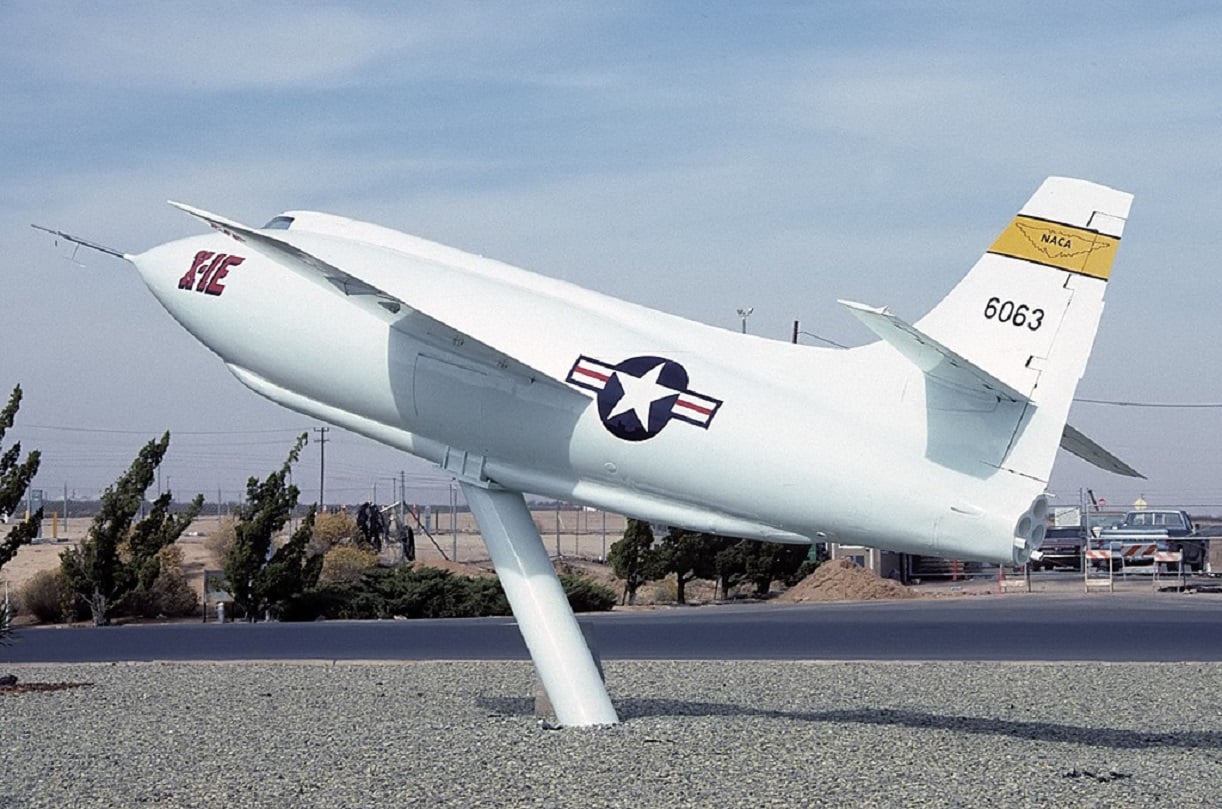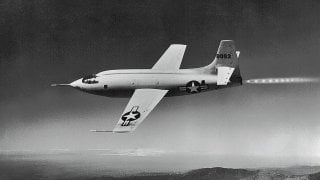Bell X-1: The First Plane to Break the Sound Barrier and Hit Mach 1
The Bell X-1 program showed that the United States aerospace efforts exhibited maximum innovation and ingenuity. It was an exciting time for aviation as the aircraft ushered in the supersonic age.
Meet the X-1: When it comes to testing airplanes the “X” designation means experimental. The first X aircraft was built in 1945 by Bell in partnership with the U.S. Army Air Forces (later named the Air Force) and NACA (which became NASA). The Bell X-1 was the first aircraft to break the sound barrier. It was flown by famed test pilot Chuck Yeager who was able to coax ultra-high speeds out of the X-1. Yeager pushed the X-1 to a speed of 700 miles per hour (MACH 1.06) to beat the sound barrier on October 14, 1947, at an altitude of 43,000 feet.
Carried and Deployed by a Bomber
The X-1 was airlifted into its flight pattern by a Boeing B-29 Superfortress or B-50 and dropped. Then it sparked up its rocket engine. Yeager was far from finished after that stupendous flight over the Mojave Desert near Muroc Dry Lake, California. He pushed what he called the “Glamorous Glennis” to more record breaking feats. The X-1 flew 78 missions. By 1948, Yeager had a hot rod on his hands. The X-1 reached the speed of 957 miles per hour (MACH 1.45) at 71,900 feet.
Glide Tests Happened First
Bell received the contract to build three of the original X-1s, then called the XS-1 standing for “Experimental Sonic-1.” The first glide flight test happened in October 1946 while the first powered flight was conducted in December of that year.
Powerful Engine
The X-1 four-chamber rocket engine had 6,000 pounds of thrust. The engine initially used nitrogen pressurization for the fuel system. The fuel system was comprised of “two propellant tanks and twelve nitrogen spheres for fuel and cabin pressurization.”
Test Bed Reveals Remarkable Data
The X-1 became a research and technology demonstrator with other test pilots under the supervision of NACA. The aircraft pushed the envelope to collect data on various maneuvers including turns and pull-ups. Engineers and scientists studied the “wing pressure distribution, stability and control, and stabilizer effectiveness.”
Reaching and Besting MACH 2
There were three versions of the X-1, and two models were grounded and canceled due to the dangers of the nitrogen fuel tanks exploding. One variant had a turbopump rather than running on nitrogen pressure. This enabled the nitrogen fuel tanks to be removed, and the reduced weight allowed for a maximum speed of MACH 2.4.
X-1-3 Exploded
After the Air Force canceled the third X-1, NACA took over its testing. That’s when an accident happened in which the third X-1 exploded in 1951. This resulted in the destruction of both the experimental craft and the B-50. The test pilot suffered serious burns and spent almost a year recovering.
More on Chuck Yeager
Yeager had earlier made his final flight on the X-1 in 1950. Yeager was one of the most colorful test pilots in history. He originally beat out 125 pilots who had more experience to fly the X-1. After his X-1 exploits, Yeager continued flying experimental aircraft throughout the 1950s. He even flew 120 combat missions in Vietnam.

Meeting Yeager
I once interviewed Yeager when I was a young journalist in the late 1990s. Yeager was crusty, grouchy, and reticent to talk to the media, but he answered my questions about his long history of flying. I was starstruck and didn’t dare ask any tough queries. He said that he was just doing his job. Now I can say I met the legendary pilot.

The Bell X-1 program showed that the United States aerospace efforts exhibited maximum innovation and ingenuity. It was an exciting time for aviation as the aircraft ushered in the supersonic age. Glamorous Glennis now resides at the National Air and Space Museum.
About the Author: Dr. Brent M. Eastwood
Dr. Brent M. Eastwood is the author of Humans, Machines, and Data: Future Trends in Warfare. He is an Emerging Threats expert and former U.S. Army Infantry officer. You can follow him on Twitter @BMEastwood. He holds a Ph.D. in Political Science and Foreign Policy/ International Relations.
All images are Creative Commons.


